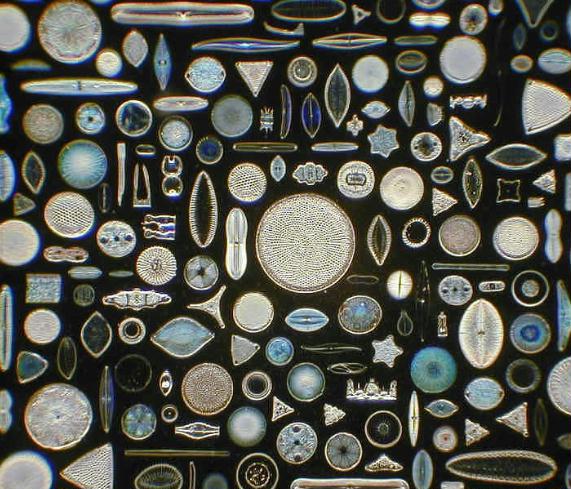
Preface. The IPCC, like economists, assumes our economy and burning of fossil fuels will grow exponentially until 2100 and beyond, with no limits to growth. But conventional oil peaked and has stayed on a plateau since 2005, so clearly peak global oil production is in sight. As is peak soil, aquifer depletion, biodiversity destruction, and deforestation to name just a few existential threats besides climate change.
The lack of attention to microbes in the IPCC model further weakens their predictions about the trajectory of climate change. As this article notes, diatoms are our friends, they “perform 25–45% of total primary production in the oceans, owing to their prevalence in open-ocean regions when total phytoplankton biomass is maximal. Diatoms have relatively high sinking speeds compared with other phytoplankton groups, and they account for ~40% of particulate carbon export to depth”.
Diatoms didn’t appear until 40 million years ago, and sequester so much carbon that they caused the poles to form ice caps. So certainly scientists should study whether their numbers are decreasing or increasing. But also the IPCC needs to include diatoms and other microbes in their models. It’s a big deal that they haven’t, since microorganisms support the existence of all higher life forms.
Alice Friedemann www.energyskeptic.com author of “When Trucks Stop Running: Energy and the Future of Transportation”, 2015, Springer and “Crunch! Whole Grain Artisan Chips and Crackers”. Podcasts: Derrick Jensen, Practical Prepping, KunstlerCast 253, KunstlerCast278, Peak Prosperity , XX2 report
* * *
University of New South Wales. 2019. Leaving microbes out of climate change conversation has major consequences, experts warn. Science Daily.
Original article: Cavicchioli, R., et al. 2019. Scientists’ warning to humanity: microorganisms and climate change. Nature Reviews Microbiology.
More than 30 microbiologists from 9 countries have issued a warning to humanity — they are calling for the world to stop ignoring an ‘unseen majority’ in Earth’s biodiversity and ecosystem when addressing climate change.
The researchers are hoping to raise awareness both for how microbes can influence climate change and how they will be impacted by it — calling for including microbes in climate change research, increasing the use of research involving innovative technologies, and improving education in classrooms.
“Micro-organisms, which include bacteria and viruses, are the lifeforms that you don’t see on the conservation websites,” says Professor Cavicchioli. “They support the existence of all higher lifeforms and are critically important in regulating climate change. “However, they are rarely the focus of climate change studies and not considered in policy development.”
Professor Cavicchioli calls microbes the ‘unseen majority’ of lifeforms on earth, playing critical functions in animal and human health, agriculture, the global food web and industry.
For example, the Census of Marine Life estimates that 90% of the ocean’s total biomass is microbial. In our oceans, marine lifeforms called phytoplankton take light energy from the sun and remove carbon dioxide from the atmosphere as much as plants. The tiny phytoplankton form the beginning of the ocean food web, feeding krill populations that then feed fish, sea birds and large mammals such as whales.
Marine phytoplankton perform half of the global photosynthetic CO2 fixation and half of the oxygen production despite amounting to only ~1% of global plant biomass. In comparison with terrestrial plants, marine phytoplankton are distributed over a larger surface area, are exposed to less seasonal variation and have markedly faster turnover rates than trees (days versus decades). Therefore, phytoplankton respond rapidly on a global scale to climate variations.
Sea ice algae thrive in sea ice ‘houses’. If global warming trends continue, the melting sea ice has a downstream effect on the sea ice algae, which means a diminished ocean food web.
“Climate change is literally starving ocean life,” says Professor Cavicchioli.
Beyond the ocean, microbes are also critical to terrestrial environments, agriculture and disease.
“In terrestrial environments, microbes release a range of important greenhouse gases to the atmosphere (carbon dioxide, methane and nitrous oxide), and climate change is causing these emissions to increase,” Professor Cavicchioli says.
“Farming ruminant animals releases vast quantities of methane from the microbes living in their rumen — so decisions about global farming practices need to consider these consequences.
“And lastly, climate change worsens the impact of pathogenic microbes on animals (including humans) and plants — that’s because climate change is stressing native life, making it easier for pathogens to cause disease.
“Climate change also expands the number and geographic range of vectors (such as mosquitos) that carry pathogens. The end result is the increased spread of disease, and serious threats to global food supplies.”
Greater commitment to microbe-based research needed
In their statement, the scientists call on researchers, institutions and governments to commit to greater microbial recognition to mitigate climate change.
“The statement emphasizes the need to investigate microbial responses to climate change and to include microbe-based research during the development of policy and management decisions,” says Professor Cavicchioli.
Additionally, climate change research that links biological processes to global geophysical and climate processes should have a much bigger focus on microbial processes.
“This goes to the heart of climate change, so if micro-organisms aren’t considered effectively it means models cannot be generated properly and predictions could be inaccurate,” says Professor Cavicchioli.
“Decisions that are made now impact on humans and other forms of life, so if you don’t take into account the microbial world, you’re missing a very big component of the equation.”
Professor Cavicchioli says that microbiologists are also working on developing resources that will be made available for teachers to educate students on the importance of microbes.
“If that literacy is there, that means people will have a much better capacity to engage with things to do with microbiology and understand the ramifications and importance of microbes.”

5 Responses to Microbes a key factor in climate change